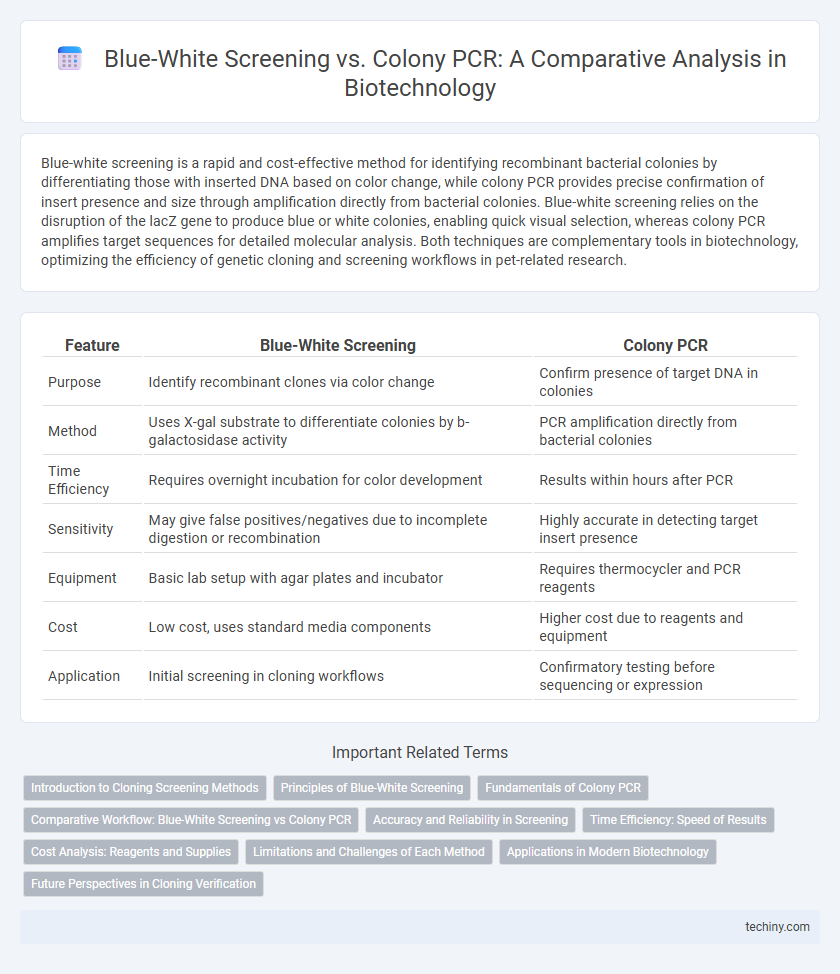Blue-white screening is a rapid and cost-effective method for identifying recombinant bacterial colonies by differentiating those with inserted DNA based on color change, while colony PCR provides precise confirmation of insert presence and size through amplification directly from bacterial colonies. Blue-white screening relies on the disruption of the lacZ gene to produce blue or white colonies, enabling quick visual selection, whereas colony PCR amplifies target sequences for detailed molecular analysis. Both techniques are complementary tools in biotechnology, optimizing the efficiency of genetic cloning and screening workflows in pet-related research.
Table of Comparison
| Feature | Blue-White Screening | Colony PCR |
|---|---|---|
| Purpose | Identify recombinant clones via color change | Confirm presence of target DNA in colonies |
| Method | Uses X-gal substrate to differentiate colonies by b-galactosidase activity | PCR amplification directly from bacterial colonies |
| Time Efficiency | Requires overnight incubation for color development | Results within hours after PCR |
| Sensitivity | May give false positives/negatives due to incomplete digestion or recombination | Highly accurate in detecting target insert presence |
| Equipment | Basic lab setup with agar plates and incubator | Requires thermocycler and PCR reagents |
| Cost | Low cost, uses standard media components | Higher cost due to reagents and equipment |
| Application | Initial screening in cloning workflows | Confirmatory testing before sequencing or expression |
Introduction to Cloning Screening Methods
Blue-white screening utilizes the disruption of the lacZ gene to distinguish recombinant from non-recombinant bacterial colonies, enabling rapid identification of successful cloning events through colorimetric changes on X-gal plates. Colony PCR directly amplifies target DNA sequences from bacterial colonies to confirm the presence and correctness of inserted genetic material, providing precise molecular validation. Both techniques are essential in molecular cloning workflows for efficient screening and verification of recombinant clones.
Principles of Blue-White Screening
Blue-white screening utilizes the disruption of the lacZ gene encoding b-galactosidase to differentiate recombinant from non-recombinant bacterial colonies. When a DNA fragment inserts into the multiple cloning site within lacZ, it inactivates b-galactosidase, preventing cleavage of X-gal substrate and resulting in white colonies. Blue colonies indicate functional b-galactosidase activity due to the absence of insert DNA, allowing efficient visual identification of successful recombinant clones.
Fundamentals of Colony PCR
Colony PCR is a molecular biology technique used to rapidly screen bacterial colonies for the presence of specific DNA sequences by directly amplifying target DNA from bacterial cells without prior plasmid isolation. This method involves selecting a small portion of a colony, lysing the cells to release DNA, and performing PCR with primers specific to the region of interest, enabling quick verification of successful cloning events. Unlike blue-white screening, which relies on colorimetric detection of recombinant plasmids, colony PCR provides precise genetic confirmation, making it essential for validating insert presence and orientation in recombinant DNA studies.
Comparative Workflow: Blue-White Screening vs Colony PCR
Blue-White Screening involves plating transformed bacteria on X-gal containing media to visually identify recombinant colonies through color differentiation, while Colony PCR directly amplifies DNA from bacterial colonies for rapid screening of recombinant clones. The Blue-White Screening workflow typically requires overnight incubation and color development before selection, whereas Colony PCR offers faster results by bypassing plating and relying on PCR amplification within hours. Both techniques complement cloning verification, with Blue-White Screening providing phenotypic confirmation and Colony PCR delivering molecular validation.
Accuracy and Reliability in Screening
Blue-White Screening offers a rapid visual method for distinguishing recombinant from non-recombinant colonies by detecting insertional inactivation of the lacZ gene, providing moderate accuracy but potential false positives due to partial digestion or background expression. Colony PCR provides higher accuracy and reliability by directly amplifying the target insert from individual colonies, enabling precise confirmation of recombinant clones and minimizing screening errors. Combining both methods can optimize screening efficiency by balancing speed and molecular verification in genetic engineering workflows.
Time Efficiency: Speed of Results
Blue-White Screening provides results in 24-48 hours by indicating successful cloning through color differentiation on selective media. Colony PCR delivers faster results within 2-4 hours by directly amplifying target DNA from bacterial colonies without the need for overnight growth. Time efficiency in molecular cloning often favors Colony PCR for rapid verification, while Blue-White Screening offers visual confirmation but requires longer incubation.
Cost Analysis: Reagents and Supplies
Blue-white screening requires X-gal and IPTG for indicator plates, which increases reagent costs compared to colony PCR that primarily uses standard PCR reagents and agarose gels. Colony PCR often reduces expenses by eliminating the need for specialized substrates and additional incubation steps inherent in blue-white screening. Overall, colony PCR tends to be more cost-effective for rapid screening, while blue-white screening incurs higher reagent costs due to the specific chemicals used.
Limitations and Challenges of Each Method
Blue-white screening faces limitations such as false positives due to incomplete lacZ gene disruption and background colonies from partial substrate hydrolysis, complicating accurate mutant identification. Colony PCR challenges include PCR inhibitors present in bacterial cells and variability in amplification efficiency, often requiring protocol optimization for reliable results. Both methods demand careful handling to overcome issues of specificity and sensitivity in genetic screening processes.
Applications in Modern Biotechnology
Blue-White Screening is extensively utilized in cloning to differentiate recombinant bacteria by colorimetric identification of successful gene insertions. Colony PCR complements this method by enabling rapid genetic verification of DNA sequences directly from bacterial colonies without the need for plasmid isolation. Together, these techniques accelerate molecular cloning workflows, enhancing efficiency in genetic engineering, synthetic biology, and recombinant protein production.
Future Perspectives in Cloning Verification
Advancements in cloning verification emphasize integrating Blue-White Screening with Colony PCR to enhance accuracy and efficiency in genetic engineering workflows. Emerging automated platforms and CRISPR-based methodologies promise to streamline verification processes, reducing false positives associated with traditional Blue-White assays. Future perspectives highlight the potential of combining real-time PCR analytics and machine learning algorithms to enable high-throughput, precise identification of recombinant clones.
Blue-White Screening vs Colony PCR Infographic

 techiny.com
techiny.com